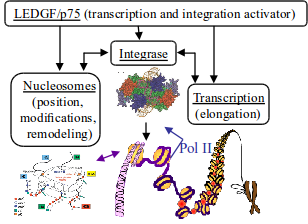Accueil du site > Thèmes de recherche > Chromatin and Retroviral Integration. Project leader : Marc Lavigne.
Chromatin and Retroviral Integration. Project leader : Marc Lavigne.
Equipe Visiteuse (M. Lavigne)
PrésentationTeam leader ( Chef d’Equipe ) :
- Marc Lavigne, Research Associate, Pasteur Institute, Paris, on secondement to the LJC
Team members ( Membres de l’Equipe ) :
- Monica Naughtin, Post-Doctoral Fellow, CNRS
- Johan Xavier, PhD Student, BMIC, ENS Lyon, ANRS
- Mehdi Morchikh, PhD Student, IVIV, ParisVI, Pasteur Institute, Paris
Projects :
Retroviral replication requires the integration of a cDNA copy of the viral RNA genome into the host genome. This critical step is performed by a viral-encoded enzyme, called integrase. In the case of HIV-1, this enzyme is a new and attractive target for anti-viral therapeutics and several integrase inhibitors are currently undergoing clinical trials. However, viruses resistant to these inhibitors have already emerged and novel integrase targets need to be identified, such as its selectivity towards cellular chromatin. To date, only one cellular parameter, the lens epithelium-derived growth factor (LEDGF/p75), has been clearly demonstrated to be involved in integration selectivity. This protein interacts with both integrase and chromatin and targets integration towards active genes. Two other parameters are very probably involved in the selectivity of integration, the chromatin architecture and the PolII transcriptional process.
During the last years, we have been involved in the identification of the following characteristics of HIV-1 integration :
- activation of HIV-1 integration by the cellular LEDGF/p75 cofactor requires its PWWP domain interacting with chromatin (Botbol et al., 1998 ; Shun et al., 1998)
- in vitro concerted integration of the two LTR viral ends into polynucleosome templates depends on the stability, regularity and remodeling of the nucleosomes (Lesbats et al., in press).
Our present projects aim to determine the role of chromatin structure, the LEDGF/p75 protein, and the RNA pol II transcription process as regulators of HIV-1 integrase selectivity and the mechanisms of this regulation. Our studies are mainly performed in vitro using enzymatic assays and biophysical tools. Integration assays into various chromatin templates are performed to study the role of nucleosome positioning, remodeling and structural modifications. The interaction between integrase and these chromatin templates is visualized by Atomic Force Microscopy. Finally, transcription is performed in vitro on these chromatin templates and its consequence on integration efficiency and selectivity is studied.
We also work on the following projects related to retroviral integrases :
- the design of chimera integrases targeted towards heterochromatin for a safer integration of retroviral vectors used in gene therapy (with O. Cohen-Haguenauer, ENS Cachan and F-L Cosset, ENS Lyon)
- the comparison of retroviral and yeast retroelements integrases (with P. Lesage, Saint Louis Hospital, Paris and J. Acker, CEA, Gif sur Yvette)
The development of our new team and its projects relies on our experience in biochemistry of retroviral integrase and chromatin, coupled with a collaboration with the permanent team of the LJC, specialized in biophysical studies of chromatin. We wish that a better understanding of the mechanisms and structures involved during HIV-1 integration into chromatin, will help to propose new therapeutic treatments, from the identification of anti-viral drugs to the development of new integrases for a safer delivery of gene therapy vectors.

Figure : Links between three major regulators of HIV-1 integration : nucleosomes, PolII transcription and the LEDGF/p75 cellular protein
Selected publications :
- Lavigne, M., Francis N.J., King, I.F.G. & Kingston, R.E.K. (2004) Propagation of silencing : Recruitment and repression of naive chromatin in trans by Polycomb repressed chromatin. Molecular Cell. 13, 415-425.
- Botbol, Y., Raghavendra, N.K., Rahman, S. Engelman, A. & Lavigne, M. (2008) Chromatinized templates reveal the requirement for the LEDGF/p75 PWWP domain during HIV-1 integration in vitro, Nucleic Acids Research 36, 1237-46
- Shun, M-C. Botbol, Y., Li, X., Di Nunzio, F. Daigle, J.E., Yan, N., Lieberman, J., Lavigne, M. & Engelman, A. (2008) Identification and characterization of PWWP domain residues critical for LEDGF/p75 chromatin binding and human immunodeficiency virus type 1 infectivity. Journal of Virology 82, 11555-567
- Lavigne M, Eskeland R, Azebi S, Saint-André V, Jang SM, Batsché E, Fan HY, Kingston RE, Imhof A, Muchardt C. (2009) Interaction of HP1 and Brg1/Brm with the globular domain of histone H3 is required for HP1-mediated repression. PLoS Genet. 5(12):e1000769. Epub .
- Lesbats, P., Botbol, Y., Chevereau, G., Vaillant, C., Calmels, C., Arnéodo, A., Androlea, M. L., Lavigne, M. & Parissi, V. Remodeling factors open the way for HIV-1 concerted integration into stable chromatin, PLOS Pathogens, in press


